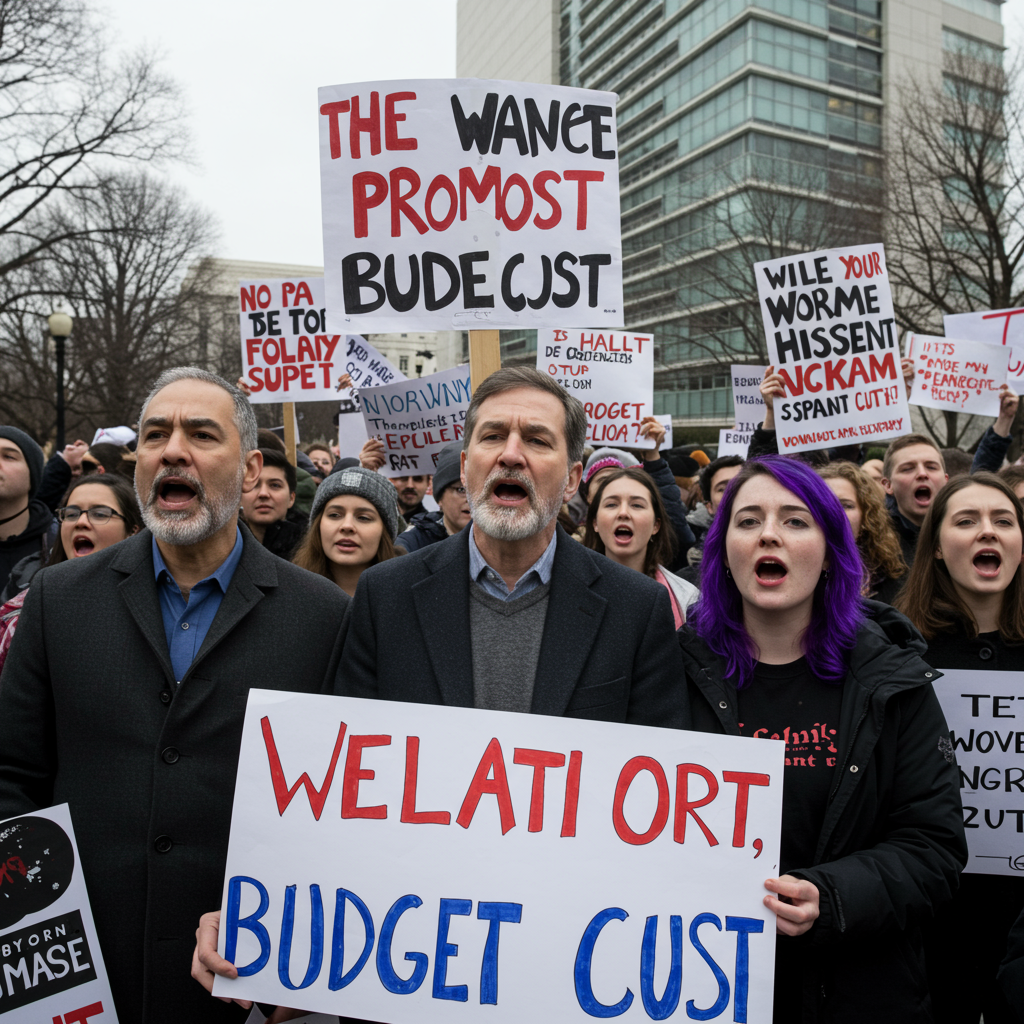A significant demonstration is set to unfold outside NASA Headquarters in Washington, D.C., on Monday, June 30, 2025. From 7:00 to 11:00 am EDT, protesters will gather to voice fierce opposition to proposed budget cuts targeting key space programs and the agency’s workforce. This planned event highlights deep concerns about the future of U.S. space exploration and scientific research under the current administration’s fiscal proposals. Organizers aim to raise public awareness and apply pressure on Congress before the next budget is finalized.
The protest comes amidst proposals that could significantly reshape NASA. Reports suggest potential cuts affecting crucial areas like the Artemis lunar missions. More broadly, the administration’s budget plan could lead to a reduction of nearly one-third of NASA’s overall workforce agency-wide. Specific facilities face particularly steep proposed cuts; for instance, the NASA Glenn Research Center in Cleveland, Ohio, could see the elimination of 554 civil servant positions, impacting almost 40% of its staff.
Why NASA Employees and Supporters Are Protesting Budget Cuts
The motivations behind the June 30th protest are multi-faceted and rooted in anxieties about the profound impact of reduced funding. At the forefront is the fear of extensive job losses. These cuts are not just numbers on a page; they represent real people with specialized skills vital to complex space and aeronautics projects. The proposed 40% reduction at NASA Glenn, for example, threatens a center known for critical research functions, including the unique Icing Research Tunnel essential for aircraft safety testing. Current and former employees emphasize that losing these dedicated civil servants means losing irreplaceable expertise and capabilities not easily replicated in the private sector.
Beyond direct job impacts, the cuts raise alarms about the future of scientific research and exploration. Sources indicate that science funding at NASA could be nearly halved under the proposed budget. This drastic reduction could severely hamper ongoing missions and limit the agency’s ability to pursue ambitious future endeavors. Critics worry this could lead to a “brain drain,” forcing top scientists and engineers to leave the agency and the field entirely, diminishing America’s capacity for innovation. Organizations like the Goddard Engineers, Scientists, and Technicians Association (GESTA) and the International Federation of Professional and Technical Engineers (IFPTE) have endorsed the protest, signaling widespread concern within the scientific and engineering communities.
Concerns also extend to America’s standing on the global stage. Slashing funding for flagship programs like Artemis could risk the U.S. falling behind other nations in the renewed space race. This could cede leadership and influence to countries like China and others rapidly advancing their space capabilities. Furthermore, scaling back U.S. commitments due to budget constraints could strain international collaborations, making partner agencies question NASA’s reliability in joint ventures.
Economic Ripple Effects and Community Impact
The proposed cuts carry significant economic implications, particularly for communities hosting NASA centers. The potential job losses at places like NASA Glenn have local leaders deeply concerned. The Greater Cleveland Partnership, the region’s chamber of commerce, has voiced alarm, recognizing NASA Glenn as a vital “innovation engine” for northeast Ohio and the country, leading in areas like power, propulsion, and nuclear technologies.
Economic analysis suggests a substantial ripple effect. For every directly employed NASA job, two to three additional jobs are typically supported in the local economy through ancillary services and related industries. The proposed cuts at Glenn could mean a loss of hundreds, if not thousands, of indirect jobs. Furthermore, the center contributes approximately $2 billion in annual economic activity to the Cleveland area. Reducing its operations could have a “drastic” negative effect on the region’s economic health. The protest aims to highlight these significant local and regional economic stakes to policymakers.
Protest organizers are careful to define the event’s nature. They explicitly state this is not a picket line or a strike. Participants will not attempt to prevent entry to the building. The sole intent is to raise public awareness about the potential near-future cuts and demand that the administration and the Office of Management and Budget (OMB) cease pressure for these reductions. Organizers seek to give Congress sufficient time to pass the next budget before irreversible cuts are made. Anyone can share or attend, but participants, especially NASA personnel, are strongly advised to do so off-duty, using leave, and ensure they cannot be construed as representing the government or using government resources.
NASA Management and Union Communications
NASA Headquarters management has acknowledged the planned demonstration. In internal communications to employees, the agency confirmed the protest is permitted by the Metro DC Police. They alerted staff to potential traffic disruptions and stated Headquarters would remain open with employees expected to report onsite. Management stressed the importance of exercising caution and staying aware of surroundings.
Crucially, NASA management has explicitly stated that the event is not endorsed by and does not represent the views of NASA or any employer doing business with the agency. Employees were reminded that only authorized personnel are permitted to speak on behalf of NASA and were provided contact information for the Headquarters newsroom for any media inquiries. Management confirmed they are coordinating with local authorities and monitoring the situation, directing employees to the NASA SAFE app for updates. This stance demonstrates the agency navigating the complex situation by respecting the right to protest while clearly separating itself institutionally from the event.
Meanwhile, union communications reflect the nuances and potential risks involved. The NASA Headquarters Professional Association (NHPA), Local 9 IFPTE, sent an email to its bargaining unit employees. The NHPA President noted the protest is scheduled by contractors from Goddard Space Flight Center (GSFC) and GESTA, distinguishing it from their specific Headquarters union local. The email reinforced that NHPA members are not allowed to strike. It acknowledged potential frustration but urged caution, warning employees not to get “caught up in something you may regret later with agitators and disruptors who may not have the same intention.” This guidance underscores the careful line employees must walk to participate as private citizens without jeopardizing their employment or violating regulations.
Broader Context: Impacts Across Federal Science Agencies
The planned NASA protest occurs within a broader climate of proposed changes and disruptions impacting federal science agencies. Recent events have highlighted potential instability for the federal science workforce across different parts of the government. For instance, over 1,800 employees at the National Science Foundation (NSF) were abruptly told to vacate their Alexandria, Virginia, headquarters with little notice, a move framed by officials as increasing efficiency but criticized by employees and unions as disruptive and potentially tied to proposed budget cuts affecting NSF.
Furthermore, a White House directive has instructed all agency heads, including NASA, to prepare plans for large-scale reductions in force (RIFs) and potential reorganizations. These plans require identifying target units, headcount reduction goals, and lists of essential positions. There have even been proposals floated regarding relocating agency offices, including potentially moving NASA headquarters from the Washington D.C. area to lower-cost locations in states like Texas or Florida. These directives and events across NSF, NOAA, and NIST contribute to a climate of uncertainty for federal employees and underscore the systemic pressures on government science funding and infrastructure that fuel the kind of concerns driving the NASA HQ protest.
Reactions to the situation surrounding NASA’s proposed budget and the protest are varied. Many in the scientific community, including veterans, express deep concern about the potential blows to research capabilities and U.S. competitiveness. The public and social media debate also shows mixed opinions, with supporters highlighting the vital importance of NASA’s work, innovation (like Artemis), and its inspiration value. Conversely, critics argue for fiscal responsibility, citing perceived waste within NASA and advocating for focusing on private sector advancements. This diverse feedback reflects the complexity of balancing national fiscal challenges with the desire to maintain leadership in space exploration and scientific discovery. The outcome of the budget process and events like this protest will significantly shape NASA’s trajectory and the future of federally funded science in the United States.
Frequently Asked Questions
What is the purpose of the NASA Headquarters protest?
The protest on June 30, 2025, aims to raise public awareness and provide information about present and near-future budget cuts proposed for NASA programs and the workforce. Organizers want to demand that the administration cease pressure for cuts until Congress has had a full opportunity to pass the next budget. It is intended to be a demonstration of concern, not a strike or attempt to block access to the building.
Where and when is the NASA Headquarters protest taking place?
The protest is scheduled to occur outside NASA Headquarters in Washington, D.C. The event will take place on Monday, June 30, 2025, from 7:00 am to 11:00 am EDT. The protest has obtained a formal permit from the Metro DC Police, confirming its legality. NASA employees attending must be off-duty and take care not to represent the agency.
How could proposed budget cuts impact NASA’s workforce and missions?
Proposed budget cuts under the current administration could lead to significant reductions in NASA’s workforce, potentially by nearly one-third agency-wide. Specific centers like NASA Glenn face cuts of around 40% of civil servants. These cuts threaten specific research capabilities, could nearly halve science funding, potentially delay or cancel key missions like Artemis, diminish U.S. leadership in space, and negatively impact local economies dependent on NASA centers.
The protest signifies a critical juncture in the ongoing debate over the funding and direction of U.S. space exploration and federal science. It brings together concerned employees, scientists, and supporters who fear that proposed budget reductions could have irreversible consequences for the agency’s ability to innovate, lead, and inspire. As Congress considers the budget, the demonstration serves as a visible plea to protect NASA’s vital role and invest in the nation’s future scientific and technological capacity.




